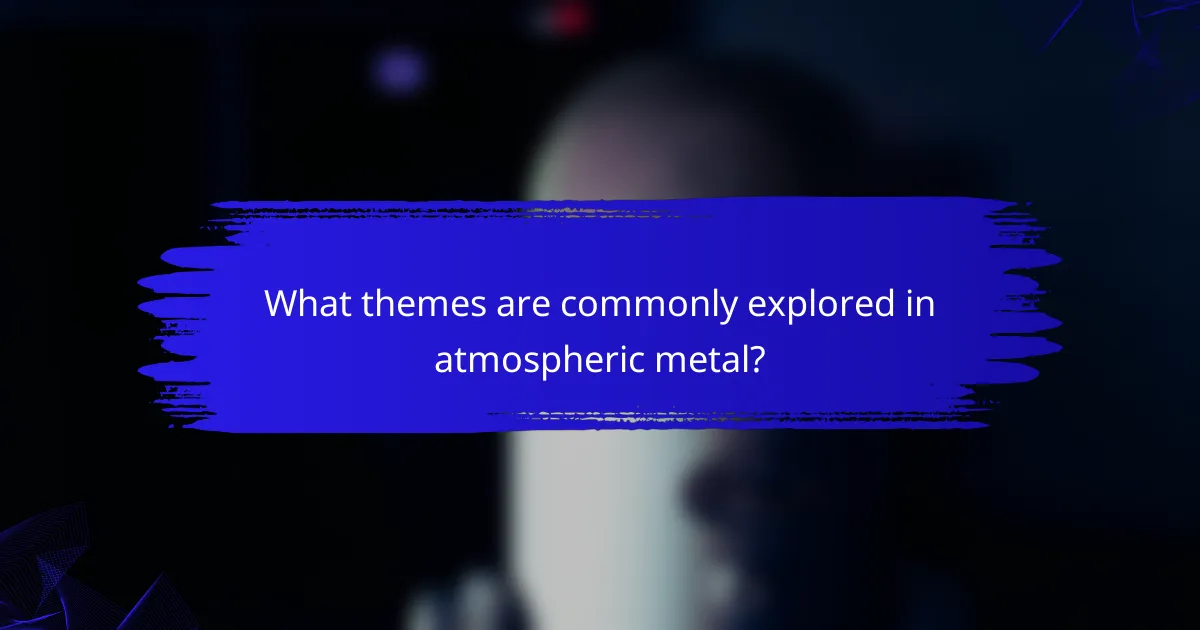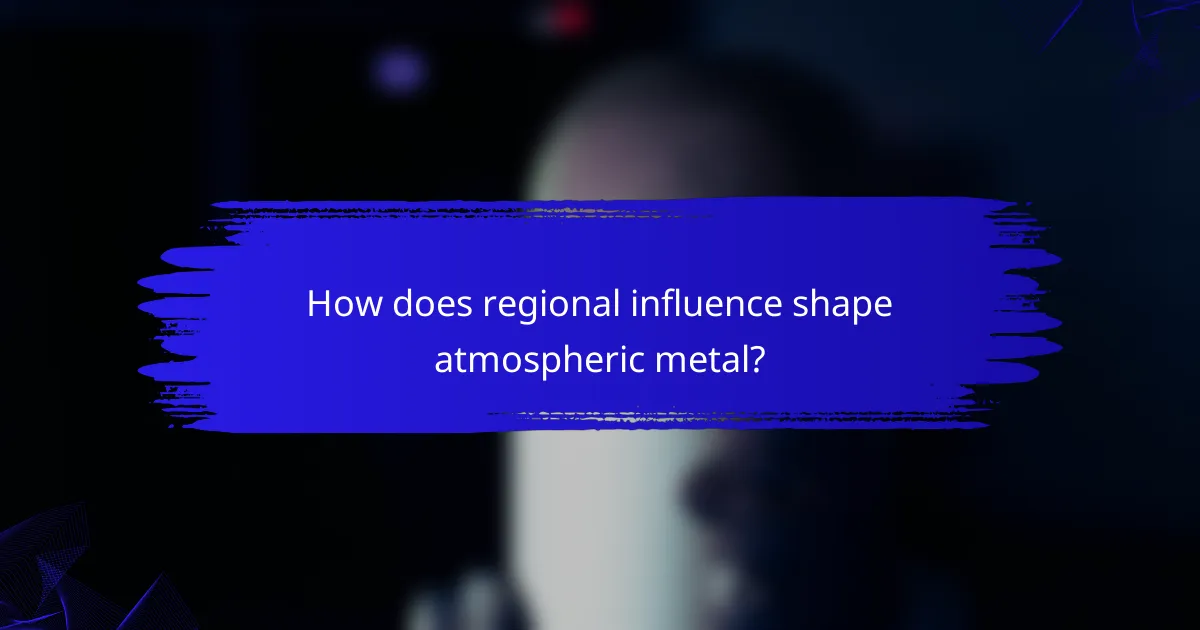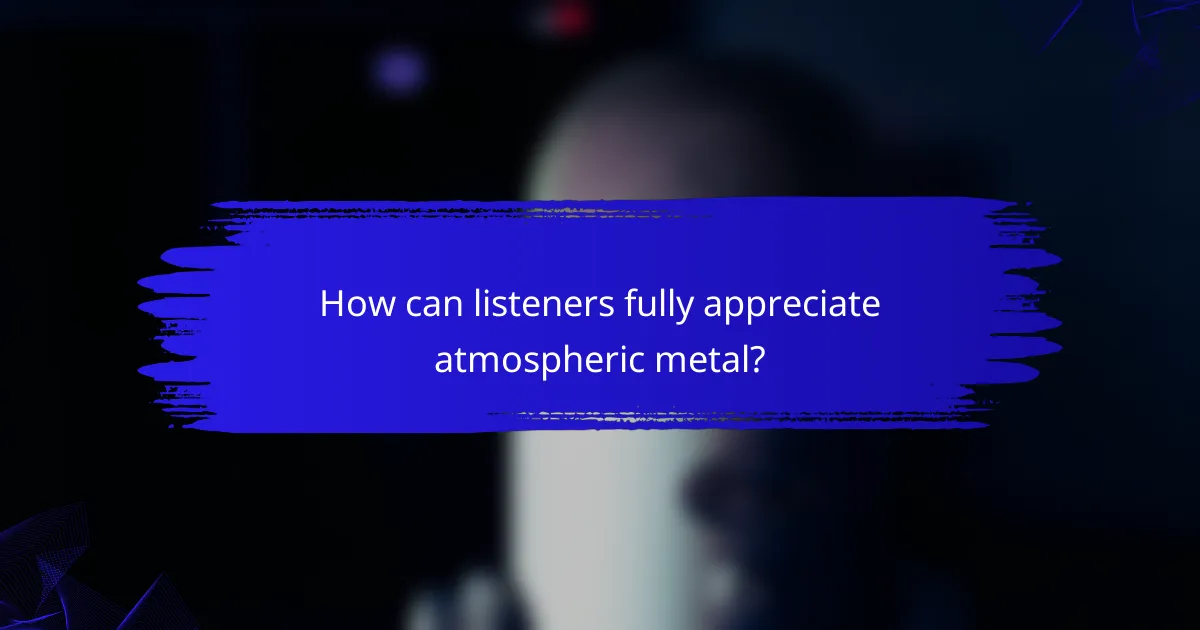Atmospheric metal captivates listeners with its immersive soundscapes and emotional depth. This genre explores themes of nature, existentialism, and introspection. Influential works highlight the unique blend of heavy and ethereal elements, showcasing regional influences and common misconceptions. Notable albums from bands like Agalloch and Alcest exemplify the genre’s profound storytelling and intricate melodies.

What are the defining characteristics of atmospheric metal?
Atmospheric metal is characterized by its immersive soundscapes, intricate melodies, and emotional depth. This genre often features ethereal vocals, atmospheric instrumentation, and a blend of heavy and soft elements. Influential works include albums that emphasize mood and themes of nature, isolation, and existentialism. The unique attribute of atmospheric metal is its ability to create a cinematic experience, transporting listeners to otherworldly realms.
How do mood and atmosphere shape the listener’s experience?
Mood and atmosphere significantly shape a listener’s experience in atmospheric metal. The genre utilizes soundscapes, tempo, and lyrical themes to evoke emotions. For instance, slow tempos and haunting melodies create a sense of melancholy, while intense crescendos can induce feelings of euphoria or aggression. Influential works like “Ágætis Byrjun” by Sigur Rós and “The Mantle” by Agalloch exemplify these effects, blending intricate instrumentation with evocative themes. The unique attribute of atmospheric metal lies in its ability to transport listeners into immersive worlds, making each experience deeply personal and transformative.
Which musical elements contribute to the atmospheric quality?
Atmospheric metal relies on various musical elements to create its immersive quality. Key components include dense guitar textures, layered vocals, and ambient soundscapes.
The use of reverb and delay effects enhances the sense of space, while dynamic shifts between heavy and soft passages contribute to emotional depth. Melodic motifs often evoke a sense of journey or exploration, reinforcing thematic narratives.
Unique attributes such as unconventional time signatures and the incorporation of orchestral instruments can further distinguish atmospheric metal, offering a rich listening experience. Influential works often exemplify these elements, showcasing how they intertwine to craft a distinctive mood.

What themes are commonly explored in atmospheric metal?
Atmospheric metal commonly explores themes of nature, existentialism, and emotional depth. These themes create immersive soundscapes that evoke feelings of solitude and introspection. Influential works often incorporate elements like ambient sound, orchestration, and lyrical imagery to enhance these themes. Notable bands include Agalloch, Alcest, and Deafheaven, each contributing unique interpretations of atmospheric metal.
How do lyrical themes enhance the emotional depth?
Lyrical themes enhance emotional depth by creating relatable narratives and evoking strong feelings. Atmospheric metal often explores complex emotions like despair, hope, and transcendence, drawing listeners into immersive experiences. This genre’s unique attributes, such as intricate storytelling and vivid imagery, allow for a profound connection between the music and the audience. Influential works exemplify how these themes resonate, making the emotional landscape richer and more impactful.
Which narratives are frequently depicted in atmospheric metal albums?
Atmospheric metal albums frequently depict narratives of nature, existentialism, and personal struggle. These themes create immersive experiences that resonate deeply with listeners.
Nature often serves as a backdrop, illustrating landscapes and environmental elements. Existentialism explores the human condition, questioning purpose and existence. Personal struggle highlights emotional battles, reflecting inner turmoil and growth.
Influential works like “The Mantle” by Agalloch and “Wildernessking” by the band of the same name exemplify these narratives. They weave intricate stories that enhance the atmospheric quality of the music.
Overall, atmospheric metal thrives on these evocative narratives, inviting listeners to explore profound themes through sound.

What are some influential works in atmospheric metal?
Influential works in atmospheric metal include albums that embody expansive soundscapes and emotional depth. Key examples are “The Mantle” by Agalloch, known for its blend of folk elements and melancholic themes, and “Frail Words Collapse” by Misery Signals, which showcases intricate guitar work and lyrical introspection. Other notable works include “A Sun That Never Sets” by Neurosis, emphasizing post-metal aesthetics, and “Lost in the Dream” by The War on Drugs, merging atmospheric rock with metal influences. These albums highlight the genre’s unique attributes, such as immersive atmospheres and profound storytelling.
Which albums are considered genre-defining?
Albums considered genre-defining in atmospheric metal include “Storm of the Light’s Bane” by Dissection, “The Mantle” by Agalloch, and “Ghost Reveries” by Opeth. These works exemplify the mood and themes that shape the genre. “Storm of the Light’s Bane” is noted for its melodic black metal elements, while “The Mantle” incorporates folk influences. “Ghost Reveries” blends progressive metal with atmospheric depth, establishing a unique sound that has influenced many artists.
How have specific bands shaped the evolution of the genre?
Specific bands have significantly influenced atmospheric metal by introducing innovative themes and soundscapes. Bands like Opeth and Agalloch have blended melodic elements with progressive structures, creating immersive experiences. Their works often explore existential themes, nature, and introspection, shaping the genre’s identity. Unique attributes, such as Opeth’s dynamic shifts between clean and growled vocals, set them apart. These contributions have led to a rich tapestry of sound that continues to evolve, inspiring new artists within the atmospheric metal scene.

How does regional influence shape atmospheric metal?
Regional influence significantly shapes atmospheric metal through cultural themes, local narratives, and unique soundscapes. Different regions contribute distinctive elements, enriching the genre’s diversity. For example, Scandinavian metal often incorporates folklore, while American metal may reflect social issues. Influential works like “Blackwater Park” by Opeth showcase regional characteristics, blending melodic and progressive styles. This interplay between geography and music creates a unique auditory experience, influencing both artists and audiences.
What are the unique attributes of atmospheric metal in different cultural contexts?
Atmospheric metal exhibits unique attributes across various cultural contexts, reflecting distinct themes and moods. For instance, in Scandinavian cultures, atmospheric metal often emphasizes nature and mythology, creating an immersive soundscape. In contrast, Japanese interpretations may blend traditional elements with modern influences, resulting in a unique fusion. Additionally, the use of ambient soundscapes in atmospheric metal can evoke feelings of isolation or introspection, resonating differently depending on cultural backgrounds. Influential works from these contexts showcase these unique attributes, highlighting the genre’s versatility and emotional depth.
How do local scenes contribute to the diversity of the genre?
Local scenes significantly enrich the diversity of atmospheric metal by introducing unique cultural influences and regional themes. Each scene contributes distinctive sounds, lyrical content, and artistic expressions that reflect local experiences. For instance, Scandinavian bands often incorporate folklore, while American groups might draw from personal struggles or societal issues. This variety fosters innovation and experimentation within the genre, leading to a broader range of moods and themes. Additionally, collaborative efforts among local musicians can create hybrid styles, further enhancing the genre’s complexity and appeal.

What are the common misconceptions about atmospheric metal?
Common misconceptions about atmospheric metal include the belief that it lacks emotional depth, is solely focused on dark themes, and is not influential in broader music genres. In reality, atmospheric metal encompasses a wide range of emotions and themes, often exploring beauty, nature, and existential concepts. Influential works in this genre demonstrate its capacity to blend heavy instrumentation with melodic elements, creating immersive soundscapes that resonate with listeners. Understanding these nuances is essential for appreciating the genre’s complexity and impact.
How does atmospheric metal differ from other metal subgenres?
Atmospheric metal differs from other metal subgenres through its focus on mood, themes, and soundscapes. It emphasizes immersive atmospheres, often incorporating elements from genres like post-rock and ambient music. Influential works, such as albums by Alcest and Agalloch, showcase ethereal melodies and lyrical themes centered on nature and introspection. This unique blend creates a distinct auditory experience that sets atmospheric metal apart from heavier subgenres like thrash or death metal.
What are the challenges faced by atmospheric metal artists?
Atmospheric metal artists face challenges including maintaining emotional depth, balancing intricate compositions, and achieving a unique sound. The genre requires a distinct blend of atmospheric elements and metal intensity. Artists often struggle with audience expectations and the niche nature of their music. Additionally, production quality can be a hurdle, as creating immersive soundscapes demands advanced technical skills and resources.

How can listeners fully appreciate atmospheric metal?
Listeners can fully appreciate atmospheric metal by immersing themselves in its mood, themes, and influential works. This genre evokes deep emotions through its soundscapes and lyrical content. Key themes often include nature, existentialism, and introspection, creating a reflective experience. Influential works, such as albums by bands like Alcest and Agalloch, showcase the genre’s ability to blend heavy instrumentation with ethereal melodies. Engaging with these elements allows listeners to connect with the music on a profound level, enhancing their overall appreciation.
What are the best practices for engaging with atmospheric metal music?
To engage with atmospheric metal music effectively, focus on its immersive qualities and emotional depth. Embrace the genre’s themes of nature, introspection, and existentialism. Listening actively enhances appreciation, allowing for deeper emotional connections. Explore influential works by bands like Opeth and Agalloch, which showcase atmospheric elements. Attend live performances to experience the genre’s intensity firsthand.
What common mistakes should listeners avoid when exploring the genre?
Listeners should avoid focusing solely on heavy instrumentation and neglecting the atmospheric elements. Many miss the subtle nuances in lyrical themes and emotional depth. Ignoring influential works can lead to a narrow understanding of the genre’s evolution. Lastly, avoid dismissing live performances, as they often enhance the overall experience and appreciation of atmospheric metal.